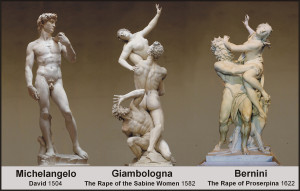With my Pieta Amare fired to a bisque I can once again focus my attention to the marble Pieta Spero. April is a cool month here in Atlantic Canada, and with nights still dipping well below freezing and daytime temperatures just inching above zero, all I can do is prepare my stone work site and wait for warmer days just around the corner.
Having several statues on the go at the same time ensures that, regardless of the seasonal temperature, I’m always busy advancing my art, switching from one project to another. The trick is to not get lost in the creative process, and never actually get around to finishing any of the work. Currently I have four statues on the go…. The Pieta Spero, and Pieta Amare, The Pear, and Bruisin
All are, to varying degrees, along the road to completion.
This is the difficulty with the creative mind… it’s leaps and bounds ahead of the creative process. There are so many designs that I would like to do, but am trapped within this temporal egg timer.
Not enough hours in the day, not enough days or months; why are there only four seasons in a year, and so few years and just one life.
Michelangelo pined that if he could have more lifetimes to dedicate, he would carve a colossus from the cliffs of Carrara.
Time is scarce, and this is why many artist prefer not to finish… or ‘Non Finito’; an artistic style that Curators and Critics applaud, and was credited to Michelangelo as its originator. What better way to witness the creative process than to trace the chisel marks or suppose what truths are trapped behind the un-carved stone.
In truth, the master had too many great ideas, too many commissions on the go, and was far too optimistic on how much he could actually complete. Pope Julius ll Tomb, was originally intended to have forty full figured statues, more than any one sculptor could complete in a lifetime. In fact most of Michelangelo’s statues were left Non Finito.
Michelangelo never intended to advance this unfinished style. When he had the time, he carved and polished to perfection. Consider; Vatican Pieta, David, Madonna of Bruges, and Moses. Also consider his monumentous achievement, The vault of the Sistine Chapel and The Last Judgement. His greatest works were all masters of completion. His Non Finito Style was simply a result of not being able to turn down a hefty commission.
In modern times, the non realistic statue is the norm; cubism, geometric abstraction, natural stone, rough, unpolished. All these expressions have the aesthetic value of balancing the visual with the emotional… but this was not the Renaissance way. As this period progressed from Michelangelo, to Giambologna, then transitioning with Bernini, the intent was always to compel emotion through captured realism.
Unfortunately, the Achilles heel to this Renaissance style is time. And this form of art is very time-consuming, and as such, very expensive.
As much as anything, the move away from realism to geometric modernism was a product of necessity. Non Finito is less expensive.

